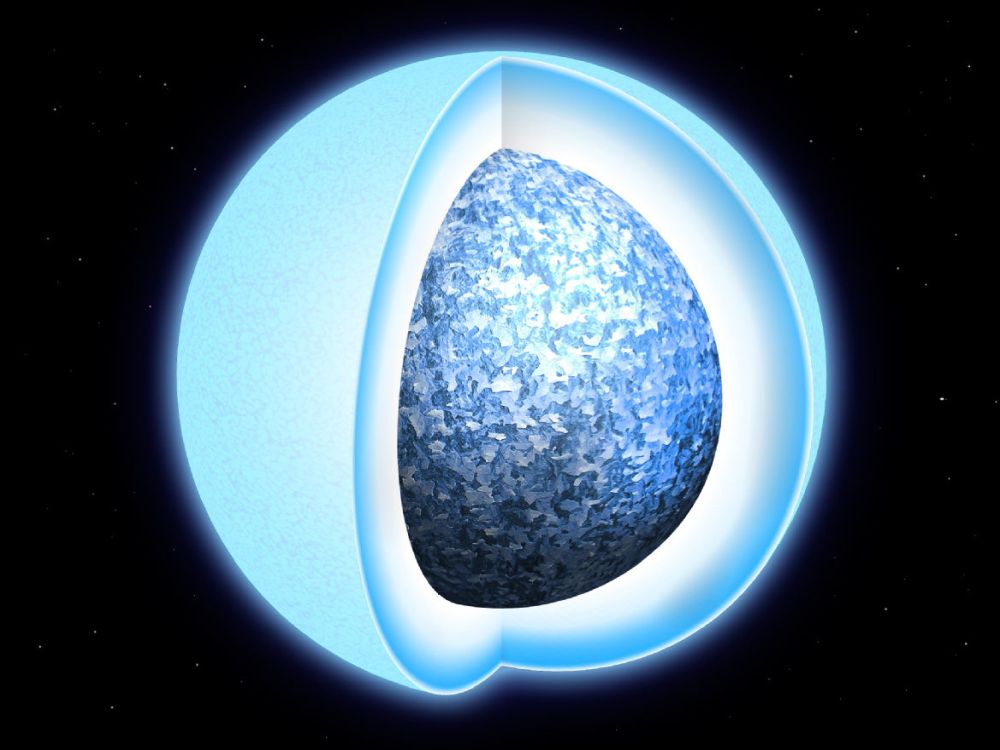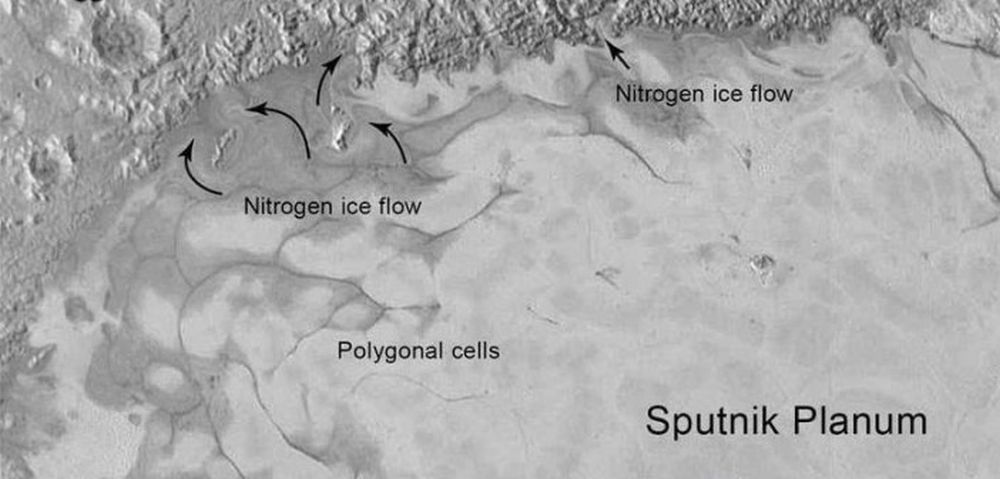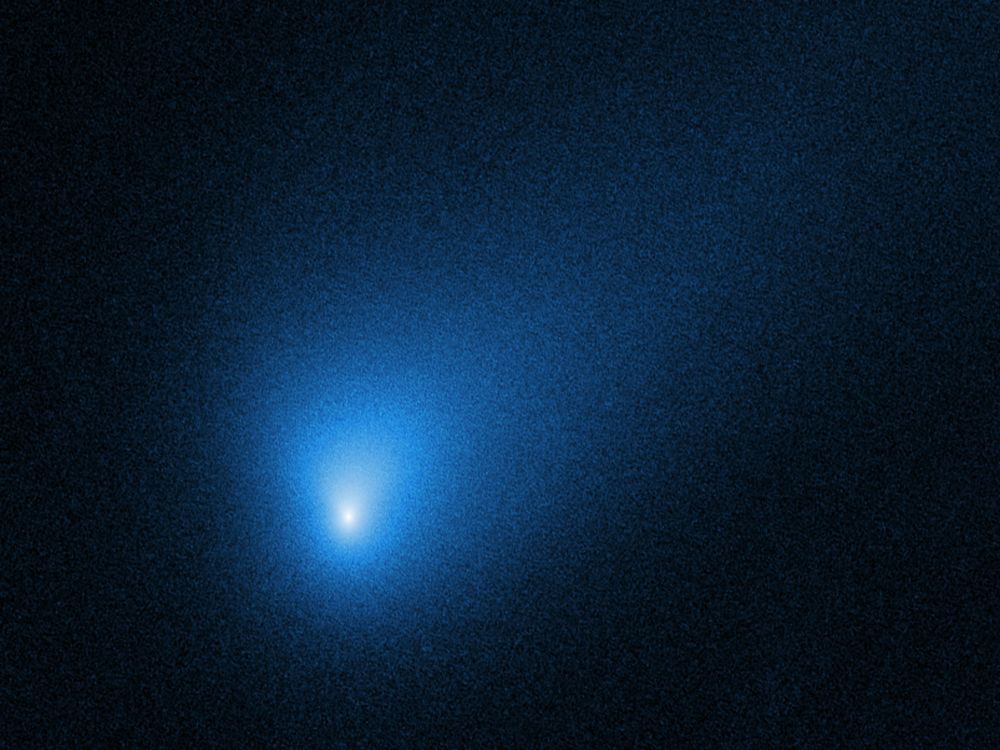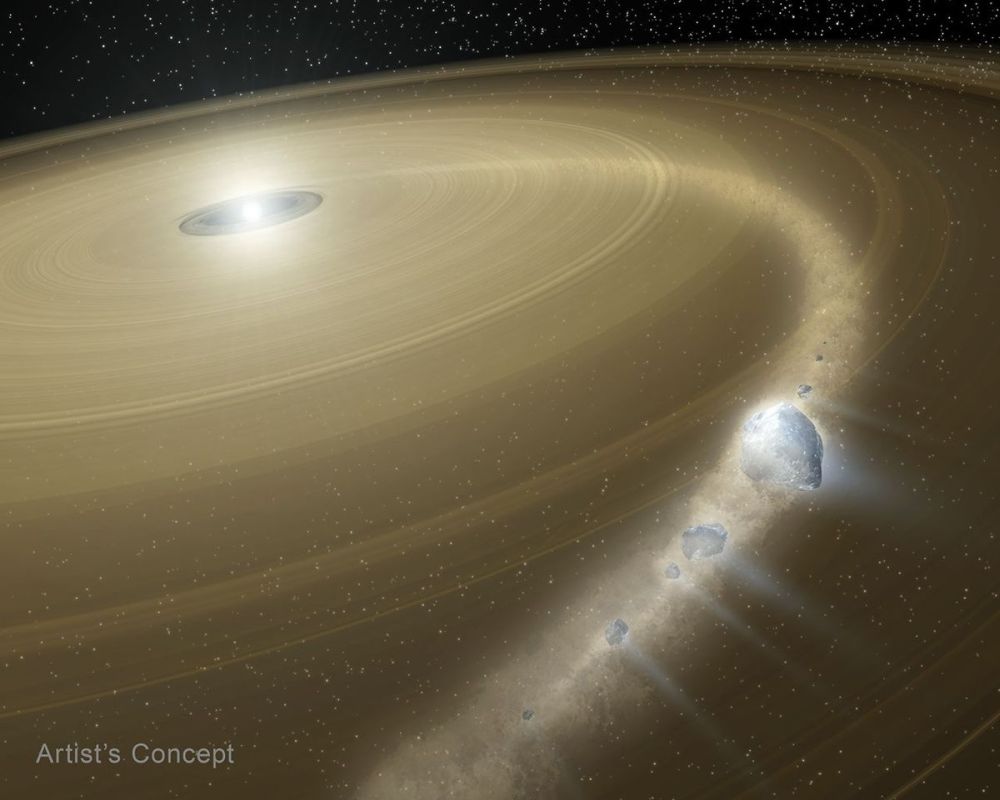The Hubble Space Telescope is still working hard despite its age. Its UV observing capabilities make it particularly well suited to studying white dwarfs. The telescope has observed a particular white dwarf on two separate occasions over the years, as it has with dozens of white dwarfs. But this particular white dwarf, named WD 1647+375 and about 260 light years away, has shown astronomers something unusual.
Many white dwarfs have been observed accreting material from rocky bodies, but in this case, the Hubble identified icy, volatile-rich material accreting onto a white dwarf. It's strong evidence that the solar system the white dwarf resides in also had a Kuiper Belt-like population of icy bodies that could've delivered water to the system's inner region when planets were forming.
The discovery is in a paper titled "Discovery of an icy and nitrogen-rich extrasolar planetesimal." It's published in the Monthly Notices of the Royal Astronomical Society, and the lead author is Snehelata Snahu from the Department of Physics at Warwick University in the UK.
"White dwarfs accreting planetary debris provide detailed insight into the bulk composition of rocky exoplanetesimals," the authors write in their research article. "However, only one Kuiper Belt analogue has been identified in that way so far."
The discovery is surprising because of what transpires in a solar system when a main sequence star transitions to a white dwarf.
White dwarfs are stellar remnants of stars not massive enough to become neutron stars or black holes. They're extremely dense and have about the same mass as the Sun, yet are only about the same size as the Earth. They're what remains when a main sequence star ages out of its life of fusion and becomes a red giant. These stars have exhausted the hydrogen in their cores and fuse hydrogen in an outer shell. Eventually, these red giants expel their outer layers, forming a planetary nebula. At the heart of that short-lived nebula sits what's left of the star: a white dwarf. This is our Sun's fate.
 *This artist's illustration shows a white dwarf. They're extremely dense and wield a powerful gravitational pull for their volume. As stars transition from main sequence, to red giant, to white dwarf, the changes wreak havoc on the star's solar system. Image Credit: University of Warwick/Mark Garlick*
*This artist's illustration shows a white dwarf. They're extremely dense and wield a powerful gravitational pull for their volume. As stars transition from main sequence, to red giant, to white dwarf, the changes wreak havoc on the star's solar system. Image Credit: University of Warwick/Mark Garlick*
The ejection of material at the end of the red giant phase wreaks havoc on the white dwarf's surroundings. Astronomers think that when our Sun goes through these dramatic changes, intense stellar winds and radiation could strip volatiles like water ice from Kuiper Belt Objects (KBO) and disrupt their orbits. Eventually the Sun will go through pulses of expulsion during which it can lose up to 50% of its mass. That will weaken the Sun's gravitational hold on KBOs, and many of them will be ejected from the Solar System. By the time the white dwarf is all that remains of the Sun, the structure of the Kuiper Belt will be destroyed or at least unrecognizable.
This is what makes this new discovery so compelling. What is an icy belt object from a distant solar system doing in such close proximity to its white dwarf?
“We were surprised,” said lead author Sahu in a press release. “We did not expect to find water or other icy content. This is because the comets and Kuiper Belt-like objects are thrown out of their planetary systems early, as their stars evolve into white dwarfs. But here, we are detecting this very volatile-rich material. This is surprising for astronomers studying white dwarfs as well as exoplanets, planets outside our solar system."
Astronomers have witnessed white dwarfs that are accreting rocky planetary matter from planets and asteroids that come too close. But finding volatiles is another matter.
"It is not unusual for white dwarfs to show signatures of calcium, iron and other metal from the material they are accreting (absorbing). This material comes from planets and asteroids that come too close to the star and are shredded and accreted. Analyzing the chemical make-up of this material gives us a window into how planetesimals outside the Solar System are composed," said Sahu.
“In this way, white dwarfs act like cosmic crime scenes — when a planetesimal falls in, its elements leave chemical fingerprints in the star’s atmosphere, letting us reconstruct the identity of the ‘victim’," Sahu said. "Typically, we see evidence of rocky material being accreted, such as calcium and other metals, but finding volatile-rich debris has been confirmed in only a handful of cases.”
Ultraviolet spectroscopy from the Hubble Space Telescope revealed the chemical makeup of the object. The material the white dwarf accreted is rich in volatiles like carbon, nitrogen, and sulphur, The researcher say that its chemical composition is analogous to our Solar System's KBOs. The material also has a high nitrogen mass fraction and large oxygen excess. Together, this indicates that the accreted planetesimal is water-rich, which supports the conclusion that it has a comet-like or dwarf planet-like composition.
The observations also revealed the strong presence of nitrogen. In fact, this is most nitrogen ever detected in white dwarf debris. That's another strong sign that the accreted object was icy. "We know that Pluto's surface is covered with nitrogen ices," said Sahu. "We think that the white dwarf accreted fragments of the crust and mantle of a dwarf planet."
 *NASA's New Horizons found nitrogen on Pluto that flow across the dwarf planet's surface like glaciers flow on Earth. Image Credit: NASA/JHUAPL/SwRI*
*NASA's New Horizons found nitrogen on Pluto that flow across the dwarf planet's surface like glaciers flow on Earth. Image Credit: NASA/JHUAPL/SwRI*
"The bulk composition and mass distribution of elements detected in the atmosphere of WD 1647+375 demonstrate that the accreted object is either a comet or a fragment of the surface of an icy dwarf planet similar to Pluto," the authors explain in their research.
But there's a potential twist to these findings, and recent events in our own Solar System bring it into focus. Discussions about white dwarfs accreting planetary material assume that the material is from the same system as the white dwarf. But the appearance of comet 3i/ATLAS, along with two other ISOs observed in recent years, shows that there's no guarantee the icy planetesimal shares the white dwarfs origins.
 Comet 2I/Borisov visited our inner Solar System in 2019. Observations showed that it shares the same basic icy nature as KBOs. Image Credit: NASA, ESA and D. Jewitt (UCLA)
Comet 2I/Borisov visited our inner Solar System in 2019. Observations showed that it shares the same basic icy nature as KBOs. Image Credit: NASA, ESA and D. Jewitt (UCLA)
"Given that three interstellar comets were identified in the Solar system within a few years, a tantalizing possibility is that some white dwarfs may accrete such interstellar comets, rather than their own," the authors write. The fact that comet 2I/Borisov shares many similarities with KBOs adds to the intrigue.
For these reasons, lead author Sahu is watching as observational results from 3i/ATLAS come in. Determining its chemical composition and water content will explain a lot about the object. "These types of studies will help us learn more about planet formation. They can also help us understand how water is delivered to rocky planets,” said Sahu.
It's difficult to distinguish between an intrinsic comet, a KBO object, or an interstellar comet in this case. There are too many unknown parameters, and the object's chemical composition only reveals so much.
But one conclusion is clear: "Our study of WD 1647+375 demonstrates the existence of icy exoplanetesimals that could deliver water and other volatiles to terrestrial planets in extrasolar systems – a pre-requisite for the development of life in other worlds," the authors write in their conclusion.
 Universe Today
Universe Today
